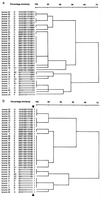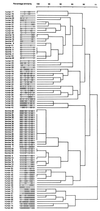Application of pulsed-field gel electrophoresis and binary typing as tools in veterinary clinical microbiology and molecular epidemiologic analysis of bovine and human Staphylococcus aureus isolates
- PMID: 10790124
- PMCID: PMC86626
- DOI: 10.1128/JCM.38.5.1931-1939.2000
Application of pulsed-field gel electrophoresis and binary typing as tools in veterinary clinical microbiology and molecular epidemiologic analysis of bovine and human Staphylococcus aureus isolates
Abstract
Thirty-eight bovine mammary Staphylococcus aureus isolates from diverse clinical, temporal, and geographical origins were genotyped by pulsed-field gel electrophoresis (PFGE) after SmaI digestion of prokaryotic DNA and by means of binary typing using 15 strain-specific DNA probes. Seven pulsed-field types and four subtypes were identified, as were 16 binary types. Concordant delineation of genetic relatedness was documented by both techniques, yet based on practical and epidemiological considerations, binary typing was the preferable method. Genotypes of bovine isolates were compared to 55 previously characterized human S. aureus isolates through cluster analysis of binary types. Genetic clusters containing strains of both human and bovine origin were found, but bacterial genotypes were predominantly associated with a single host species. Binary typing proved an excellent tool for comparison of S. aureus strains, including methicillin-resistant S. aureus, derived from different host species and from different databases. For 28 bovine S. aureus isolates, detailed clinical observations in vivo were compared to strain typing results in vitro. Associations were found between distinct genotypes and severity of disease, suggesting strain-specific bacterial virulence. Circumstantial evidence furthermore supports strain-specific routes of bacterial dissemination. We conclude that PFGE and binary typing can be successfully applied for genetic analysis of S. aureus isolates from bovine mammary secretions. Binary typing in particular is a robust and simple method and promises to become a powerful tool for strain characterization, for resolution of clonal relationships of bacteria within and between host species, and for identification of sources and transmission routes of bovine S. aureus.
Figures




References
-
- Aarestrup F M, Wegener H C, Rosdahl V T. Evaluation of phenotypic and genotypic methods for epidemiological typing of Staphylococcus aureus isolates from bovine mastitis in Denmark. Vet Microbiol. 1995;45:139–150. - PubMed
-
- Annemüller C, Lämmler C, Zschock M. Genotyping of Staphylococcus aureus isolated from bovine mastitis. Vet Microbiol. 1999;69:217–224. - PubMed
-
- Ayliffe G A J. The progressive intercontinental spread of methicillin-resistant Staphylococcus aureus. Clin Infect Dis. 1997;24:S74–S79. - PubMed
Publication types
MeSH terms
LinkOut - more resources
Full Text Sources
Other Literature Sources
Medical

